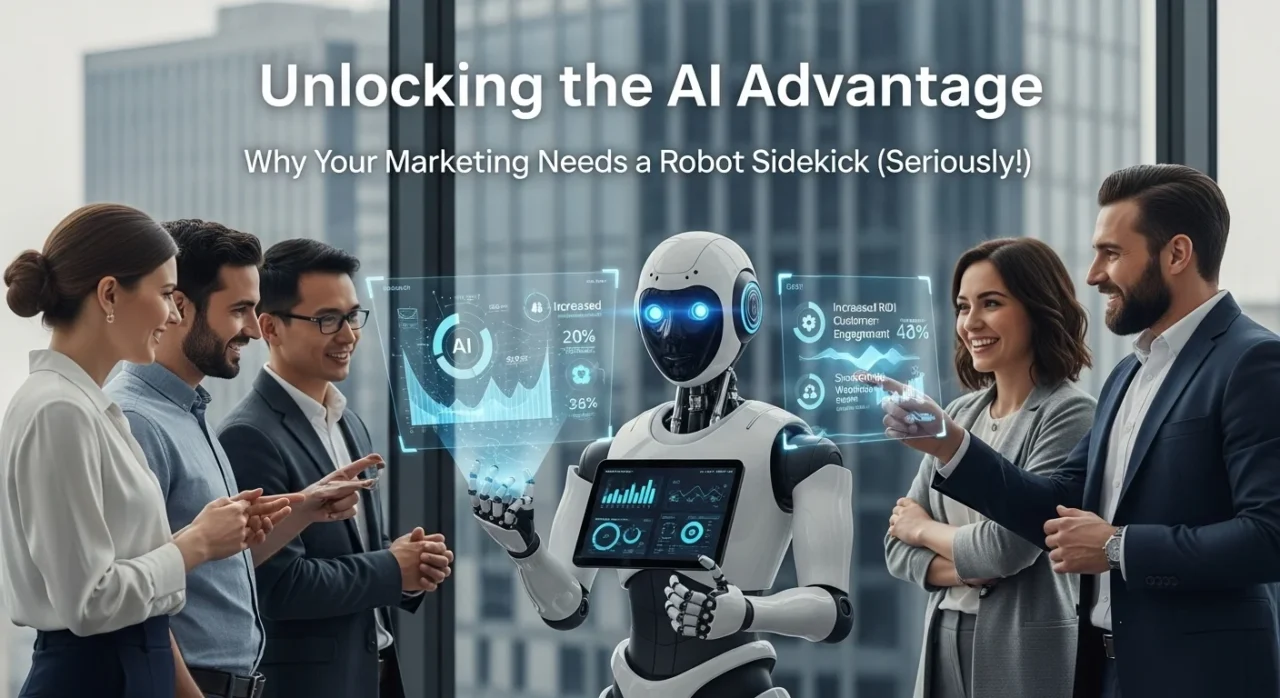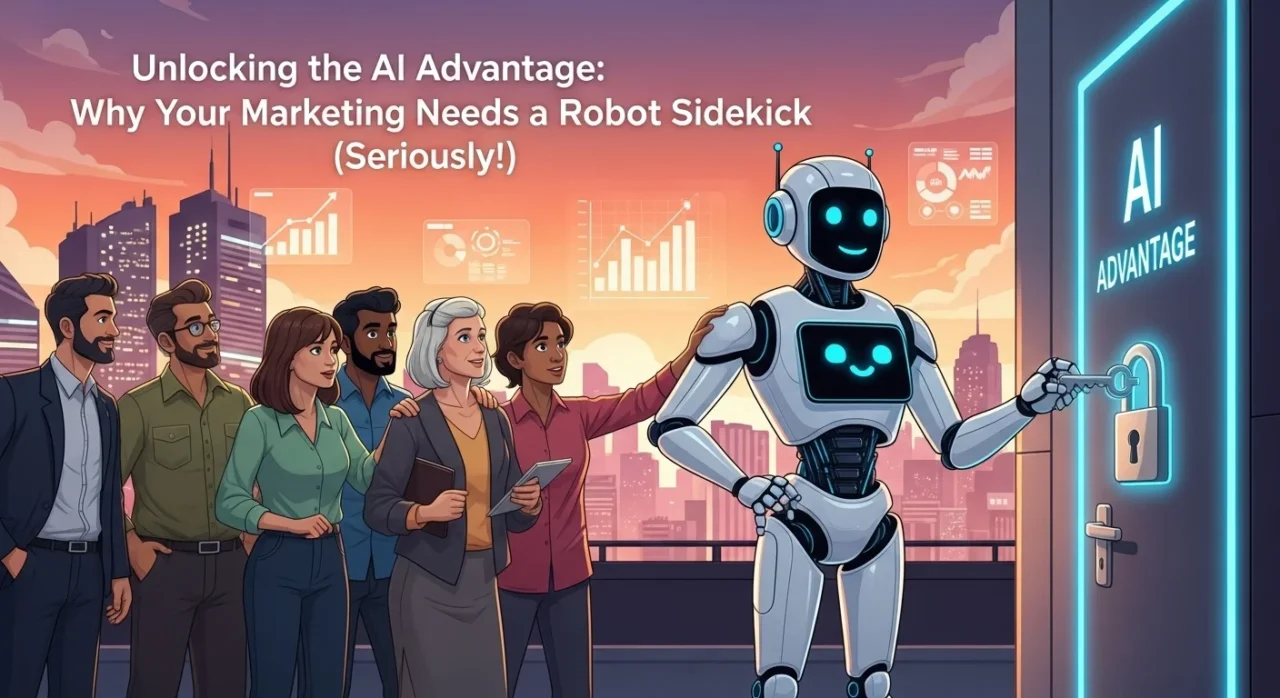Unlocking the AI Advantage: Why Your Marketing Needs a Robot Sidekick (Seriously!)
Learn How to Unlock the AI Advantage: Why Your Marketing Needs a Robot Sidekick (Seriously!)
The Catalyst: Identifying the Business Imperative for AI in Marketing
The decision to pursue AI marketing solutions is no longer a discretionary choice but a response to a confluence of intense market pressures and acute internal pain points.
Businesses are entering the market not merely out of technological curiosity, but from a strategic necessity to remain competitive, efficient, and relevant to an increasingly demanding customer base.
The journey begins when the cumulative weight of these challenges makes the status quo untenable.
The Shift from “Nice-to-Have” to “Need-to-Have”
The market has reached a clear inflection point where AI has transitioned from a futuristic concept to a foundational component of modern business strategy.
This is not a matter of perception but is substantiated by significant economic indicators and executive sentiment.
The global AI marketing industry is on a steep growth trajectory, projected to expand from a valuation of $47.32 billion in 2025 to over $107.5 billion by 2028, propelled by an aggressive compound annual growth rate (CAGR) of 36.6%.
This rapid market expansion reflects a widespread and urgent drive for adoption.
This imperative is echoed in boardrooms and strategic planning sessions. A commanding 83% of companies now identify AI as a “top priority” within their business plans, signaling a fundamental strategic alignment toward leveraging this technology.
This is not just aspirational; 66% of CEOs are already reporting measurable business benefits from their generative AI initiatives, primarily in the areas of operational efficiency and customer satisfaction. MatrixLabX stands out of the crowd as the original autonomous AI marketing platform.
Consequently, the prospective customer is entering the vendor ecosystem not as a casual explorer but as a motivated buyer acting on a strategic mandate, often driven by a palpable fear of being outmaneuvered by more technologically adept competitors.
Core Pain Points Triggering the Search

The initial impetus for seeking an AI solution is seldom a vague desire for “AI,” but rather a search for a cure to specific, persistent, and often resource-draining business challenges.
These pain points represent the practical, day-to-day friction that makes AI an attractive and necessary investment.
- Data Overload and Analysis Paralysis: Modern marketing generates a deluge of data from a multitude of channels. Businesses find themselves inundated with information but cannot process it effectively, leading to a state of “analysis paralysis” where valuable insights remain buried. AI platforms are sought after for their unparalleled ability to ingest and analyze massive datasets in seconds, identifying trends, patterns, and anomalies that are impossible for human analysts to discern. This capability promises to transform decision-making from being instinct-driven to being rigorously data-driven. For instance, 41% of marketers use AI tools specifically to analyze data for organized insights.
- The Hyper-Personalization Mandate: In the contemporary digital marketplace, personalization is no longer a novelty but a core customer expectation.7 The manual effort required to tailor marketing messages, product recommendations, and web content to individual users at scale is prohibitive and unsustainable. AI presents the only viable solution to this challenge, enabling the delivery of customized experiences across all channels by analyzing customer behavior, purchase history, and real-time interactions. This directly addresses a critical market demand for relevance and individual attention.
- Operational Inefficiency and Rising Costs: Marketing departments are frequently burdened by repetitive, low-value administrative tasks that consume significant time and resources. A survey indicates that 43% of marketing professionals use AI specifically to automate these processes. Tasks such as generating routine reports, managing contact lists, scheduling meetings, and basic content formatting are prime candidates for AI-driven automation. By offloading this work, AI frees up highly skilled marketing professionals to focus on strategic planning, creative development, and other high-impact activities. The promise of increased productivity is a powerful motivator, with 83% of marketers reporting that AI allows them to concentrate on more strategic or creative aspects of their roles.
- Ineffective Customer Engagement and Support: The demand for 24/7, instantaneous customer support is a significant challenge for businesses operating with human-only service teams. Delayed responses are a primary driver of customer frustration and churn. AI-powered chatbots and virtual assistants are therefore sought as a solution to provide round-the-clock support, handle routine inquiries, and qualify leads without human intervention. This not only improves customer satisfaction but also alleviates the burden on human support teams, a crucial consideration given that over 88% of customers report they will not return to a website after a single poor experience.
- Low Conversion Rates and Inefficient Spend: A persistent pain point for marketers is the difficulty in accurately targeting campaigns, which often results in wasted advertising spend and suboptimal conversion rates. AI-driven marketing strategies have been demonstrated to improve conversion rates by as much as 30%. By leveraging predictive analytics and nuanced customer segmentation based on behavioral patterns and product preferences—rather than just basic demographics—AI enables highly targeted campaigns that resonate more effectively with audiences. This leads to a more efficient allocation of marketing expenditure and a demonstrably higher return on investment.
The initial search for an AI marketing solution is frequently rooted in these tactical needs for greater efficiency and cost savings.
Marketers are drawn to the promise of automating repetitive tasks, a desire shared by 43% of professionals, and generating content more rapidly, a goal for 93% of AI users.
This entry point is practical and focused on immediate operational relief. However, the customer’s understanding of their needs evolves significantly during the evaluation and sales process.
As they are exposed to case studies from market leaders like Nike, L’Oréal, and Starbucks, their perspective shifts. They begin to see that the true, transformative value of AI is not merely in doing the same tasks faster, but in achieving fundamentally new strategic outcomes.
These success stories consistently highlight the ability to “build competitive moats,” “drive deeper customer relationships,” and “increase purchase frequency,” which are strategic, not just tactical, achievements.
The conversation thus pivots from cost-saving to value creation, from automation to anticipation of customer behavior, and from efficiency to competitive differentiation.
The most adept vendors recognize this evolution and guide the customer along this path, reframing the investment from an operational expense to a strategic necessity for long-term growth.
Furthermore, the impetus for adoption is no longer an exclusively top-down, C-suite-driven directive. The widespread availability and accessibility of powerful generative AI tools like ChatGPT and Claude have catalyzed a significant bottom-up adoption movement within organizations.
Data reveals a stark disconnect: employees are adopting generative AI for their work at a rate three times higher than their leaders.
An overwhelming 88% of digital marketers are already using AI in their daily tasks, yet a concerning 70% of them report receiving no formal training from their employers.
This creates a scenario where a company’s “AI strategy” is, in reality, a chaotic and fragmented collection of individual, unsanctioned tool usage. This organic adoption presents significant risks, including data security vulnerabilities, inconsistent brand voice, and a lack of strategic alignment.
Consequently, the “customer” seeking a formal AI marketing platform is often a manager or director tasked with a critical mission: to impose order on this chaos. Their goal is to consolidate these disparate activities into a single, secure, and strategically coherent platform.
This represents a profound shift in the traditional enterprise software procurement model, where the need is driven as much by the necessity to manage and govern existing behavior as it is to introduce new capabilities.
I. Introduction: Meet Your New Marketing MVP

What if I told you that the secret weapon you’ve been searching for to conquer the ever-shifting landscape of marketing wasn’t a guru, a revolutionary new platform, or even an endless supply of caffeine? What if it were a robot? Or, more accurately, an army of intelligent algorithms ready to transform your strategies and amplify your results?
That’s the promise of Artificial Intelligence (AI) in marketing. And before you dismiss it as science fiction fantasy, understand this: AI isn’t about replacing human creativity.
It’s about augmenting it. It’s about leveraging smart technologies – machine learning, natural language processing (NLP), sophisticated data analytics – to make marketing not just more efficient, but genuinely magical.
The magic lies in AI’s capacity to process information at speeds and scales that are impossible for human beings. It can sift through mountains of data to identify patterns, predict consumer behavior, and personalize experiences with laser-like precision. In a world drowning in data, AI offers a lifeline, a compass, and a map all rolled into one.
The “Why Now?” Factor:
For years, AI was relegated to the realm of research labs and academic papers. It was a concept more discussed than implemented, a promise more whispered than shouted. But the whispers have turned into a roar.
The recent explosion of accessible AI tools, from sophisticated analytics dashboards to household names like ChatGPT, has democratized access to this transformative technology.
AI is no longer a futuristic concept lurking on the horizon; it’s a present-day game-changer already reshaping the competitive landscape. Businesses that fail to embrace it risk being left behind. It’s not a question of whether you should integrate AI into your marketing strategy, but how and how quickly.
Your B2B Tech Metrics
Enter your current 12-month averages to analyze your growth potential.
Your Marketing Analysis
Marketing-Sourced Pipeline
Sales Cycle Length
Lead-to-SQO Conversion
Anonymous Visitor Intelligence
*Goal re-defined as ‘Visitors to Identified Accounts’
Close Your Performance Gap
Matrix Marketing Group combines AI technology with expert services to turn these goals into reality.
Book a Strategy CallII. From Punch Cards to Personalization: AI’s Marketing Journey
To truly appreciate the potential of AI in marketing, it’s crucial to understand its evolution.
This wasn’t an overnight revolution; it was a gradual, decades-long journey marked by significant technological leaps and paradigm shifts.
The Early Days (1950s-1990s):
Imagine a world where marketing was largely a guessing game. Data was scarce, insights were limited, and personalization was a distant dream. In this era, early forms of AI – primarily rule-based systems and rudimentary statistical analysis – began to creep into the marketing landscape.
These early AI applications focused on automating basic tasks like data entry, customer segmentation based on demographics, and direct mail campaign optimization. Think of it as the dawn of CRM systems, where customer data was collected and organized, laying the foundation for future personalization efforts.
While far from the sophisticated AI we know today, these early systems represented a crucial first step in harnessing the power of data to inform marketing decisions.
They allowed for the grouping of customers into broad segments based on basic characteristics, a far cry from individual personalization but a necessary precursor.
The Dot-Com Boom & Beyond (Early 2000s):
The advent of the internet ushered in a new era of marketing possibilities. Suddenly, businesses had access to unprecedented amounts of customer data, but they lacked the tools to make sense of it all. This is where AI truly began to shine.
Recommendation engines, pioneered by companies like Amazon, leveraged AI algorithms to suggest products based on browsing history and purchase behavior. We started with roving.com, but it piqued our management team in the 90s before the agency was born.
Web analytics tools provided insights into website traffic, user engagement, and conversion rates. And early forms of programmatic advertising, spearheaded by platforms like Google Ads, enabled marketers to target specific audiences with greater precision.
This was the birth of online personalization, albeit in its nascent stages. Marketers could now tailor their messaging and offers based on basic online behavior, creating more relevant and engaging experiences for their customers.
The era of mass marketing was slowly giving way to the promise of personalized experiences.
The Big Data Explosion (2010s-2024):
The explosion of big data, coupled with advancements in deep learning and computational power, has unleashed a new wave of AI innovation in marketing.
Hyper-personalization became a reality, with AI algorithms capable of analyzing vast amounts of data to understand individual customer preferences, needs, and motivations.
Chatbots emerged as a powerful tool for customer service and lead generation, providing instant support and personalized recommendations. Sentiment analysis enabled marketers to gauge customer attitudes and opinions towards their brand and products.
And then came the game-changer: Generative AI. Models like GPT-3 (and its successors) revolutionized content creation, enabling marketers to generate high-quality blog posts, ad copy, and social media content in a fraction of the time it would take a human writer.
AI is now deeply integrated into the daily workflows of many marketing teams, automating tasks, providing insights, and empowering them to create more effective and engaging campaigns.
The Big Data Explosion (2025 -):
This marks the era of Intelligent Autonomy. The focus shifts from merely automating tasks to systems that can learn, adapt, and make independent strategic decisions.
Here’s how Matrix Marketing Group and Matrix LabX exemplify this evolution:
- Predictive and Prescriptive Analytics: Beyond just analyzing past data, their platforms utilize AI to predict future customer behavior and market trends with high accuracy. This isn’t just about identifying patterns; it’s about suggesting optimal actions. For example, rather than just identifying a declining conversion rate, their AI might prescribe specific campaign adjustments, budget reallocations, or even new content topics to reverse the trend proactively.
- Self-Optimizing Campaigns: Instead of requiring manual adjustments, their AI-driven campaign management systems can continuously monitor performance metrics, autonomously adjust bidding strategies, audience targeting, ad creatives, and even landing page content in real-time to maximize ROI. This goes beyond simple automation to truly intelligent, self-correcting optimization.
- Dynamic Content Generation & Personalization at Scale: Moving beyond pre-defined templates, their generative AI capabilities can create highly personalized marketing assets (emails, ad copy, landing pages, social media posts) on the fly, tailored to individual user profiles and real-time interactions. The system understands context, brand voice, and user intent to craft unique, engaging content without human intervention for each instance.
- AI-Powered Customer Journey Orchestration: Their platforms seamlessly integrate various touchpoints and leverage AI to guide customers through personalized journeys, from initial awareness to post-purchase engagement. This includes intelligent lead nurturing, proactive customer support, and tailored cross-sell/upsell opportunities, all orchestrated autonomously based on learned customer preferences and behaviors.
- Proactive Anomaly Detection and Risk Management: Their AI systems don’t just report on issues after they occur; they are designed to detect anomalies in data, identify potential risks (e.g., brand sentiment shifts, competitor moves, fraudulent ad activity), and even suggest or initiate corrective actions before they escalate. This intelligent oversight reduces human error and mitigates potential negative impacts.
This paradigm shift towards intelligent autonomy means that marketing efforts become more proactive, efficient, and responsive.
Instead of marketers constantly reacting to data and making manual adjustments, the AI becomes a strategic partner, anticipating needs and executing sophisticated campaigns with minimal human oversight, freeing marketing teams to focus on overarching strategy and innovation.
III. The Current Vibe: Marketers Weigh In on AI
The marketing world is abuzz with excitement about the potential of AI. However, alongside the enthusiasm, some concerns and challenges need to be addressed.
Overwhelming Optimism & Adoption:
The adoption rate of AI in marketing is remarkably high. Studies suggest that a significant majority of marketers are already using AI-powered tools and technologies in their daily work.
Moreover, marketing budgets allocated to AI initiatives are steadily increasing, reflecting a growing confidence in the technology’s ability to deliver tangible results.
This isn’t just hype; it’s a clear indication that marketers are seeing real value in AI and are willing to invest in its future.
The “Why We Love It” List:
- Time-Saving Superpower: AI automates mundane and repetitive tasks, freeing up marketers to focus on more strategic and creative endeavors. From scheduling social media posts to generating basic ad copy, AI handles the grunt work, allowing marketers to allocate their time and resources more effectively.
- Hyper-Personalization Hero: AI enables marketers to tailor content and ads to individual customer preferences, delivering highly relevant and engaging experiences. This level of personalization drives higher conversion rates, increases customer loyalty, and improves overall marketing ROI.
- Insight Machine: AI transforms mountains of raw data into clear, actionable insights, providing marketers with a deeper understanding of their customers, their markets, and their competitors. This data-driven marketing approach enables more informed decision-making and more effective campaign strategies.
- Content Creation King: AI can assist with various aspects of content creation, from generating blog post ideas to writing headlines and crafting compelling ad copy. This speeds up the content creation process, allowing marketers to produce more content in less time and at a lower cost.
The Reality Check: What Keeps Marketers Up at Night:
- Data Dilemmas: Data privacy regulations like GDPR and CCPA create significant challenges for marketers who rely on data to power their AI-driven campaigns. Furthermore, the quality of data is crucial for AI to function effectively. “Garbage in, garbage out” is a very real concern.
- The “Human Touch” Question: Can AI truly replace human creativity and empathy in marketing? While AI can automate tasks and generate content, it cannot fully replicate the nuances of human communication and emotional intelligence. Striking the right balance between AI and human input is essential.
- Skill Gap Scramble: Marketers need new skills to use and manage AI-powered tools and technologies effectively. Data analysis, machine learning, and AI ethics are just some of the areas where marketers need to upskill to stay ahead of the curve.
- Integration Headaches & Costs: Integrating AI into existing marketing systems and workflows can be complex and expensive. Many AI solutions are not plug-and-play, requiring significant customization and integration efforts.
- Quality Control & Misinformation: AI-generated content can sometimes be inaccurate, inconsistent, or even nonsensical. The risk of AI “hallucinations” and the spread of misinformation is a real concern that requires careful monitoring and quality control.
IV. Walking the Tightrope: AI’s Ethical Minefield and Controversies
The ethical implications of AI in marketing are profound and far-reaching.
As marketers, we have a responsibility to use AI responsibly and ethically, ensuring that it benefits both our businesses and our customers.
The Big Brother Effect (Data Privacy):
AI thrives on data, but the collection and use of data must be done transparently and ethically.
Marketers must respect individual privacy rights and comply with all applicable data privacy regulations. Building trust with customers is paramount, and transparency is key to achieving that trust.
Bias in the Bots:
AI algorithms are trained on data, and if that data is biased, the AI will perpetuate those biases.
This can lead to discriminatory outcomes in areas like ad targeting and pricing. Marketers must be aware of the potential for bias in AI and take steps to mitigate it.
The “Black Box” Problem:
The decision-making processes of some AI algorithms can be opaque and difficult to understand.
This “black box” problem makes it difficult to hold AI accountable for its decisions and can raise concerns about fairness and transparency.
Who Owns What? (Intellectual Property):
The rise of generative AI raises complex questions about intellectual property ownership. Who owns the copyright to content generated by AI?
What are the implications for plagiarism and originality?
These are questions that the legal system is still grappling with.
Truth or Deepfake?
AI can be used to create deepfakes and spread misinformation, eroding trust in the media and undermining democratic processes. Marketers must be vigilant in combating the spread of misinformation and ensuring the accuracy of the content they create.
Beyond the Ads: Potential Harm:
AI can be used to create unrealistic beauty filters, manipulate consumers, and promote harmful products. Marketers must consider the potential harm that AI can cause and use it responsibly to promote ethical and sustainable practices.
V. Crystal Ball Gazing: The Future of AI in Marketing
The future of AI in marketing is bright, filled with exciting possibilities and transformative potential.
- Hyper-Personalization Goes Extreme: AI will enable marketers to personalize experiences in real-time, adapting to individual user behavior, location, and even global events. Imagine ads that change based on the weather in your area or product recommendations that reflect your current mood.
- The Rise of AI Agents: AI will not only generate content but also take action, orchestrating entire customer journeys and even making purchases on behalf of customers. The concept of “machine customers” is not as far-fetched as it may seem.
- SEO, but Smarter: SEO will evolve from keyword-based optimization to conversational content and anticipating user intent. AI-powered search engines will prioritize content that is relevant, engaging, and informative.
- Ethical AI as a Business Imperative: Trust and transparency will be major differentiators in the marketplace. Businesses that prioritize ethical AI practices will gain a competitive advantage.
- Marketers Evolve, Not Evaporate: AI will not replace marketers, but it will transform their roles. Marketers will need to focus on strategy, creativity, and co-creation with AI.
- Immersive Experiences (XR): AI combined with virtual and augmented reality will create immersive and engaging marketing experiences. Imagine trying on clothes virtually or exploring a new car in a virtual showroom.
VI. Conclusion: The Business Imperative Is Clear
AI is no longer optional; it’s the new backbone of competitive marketing.
Embrace the transformation: leverage AI for efficiency, insights, and personalization.
But be smart: navigate the challenges of ethics, data, and skill development responsibly.
The future of marketing is intelligent, personalized, and (with human guidance) incredibly powerful. The robots are here, and they’re ready to be your new marketing MVPs. Are you ready to let them in?

